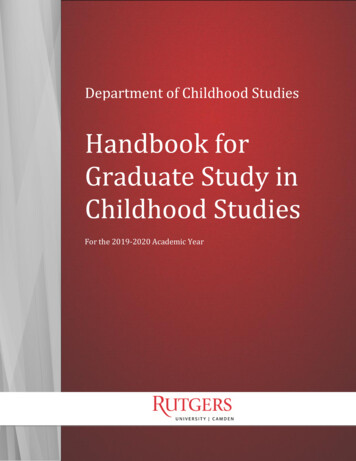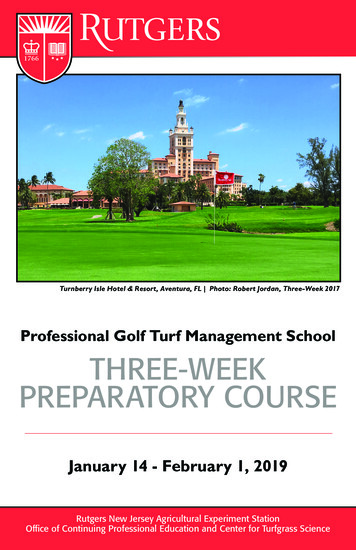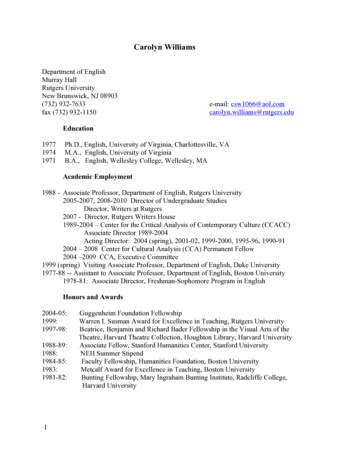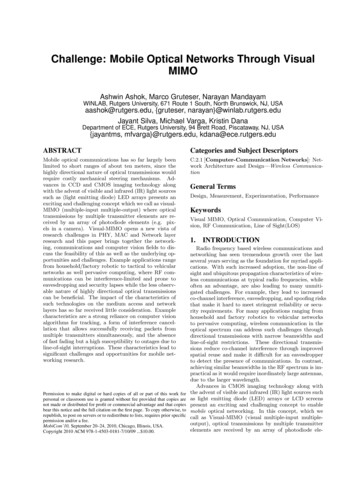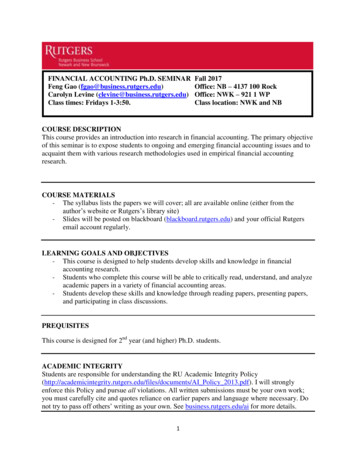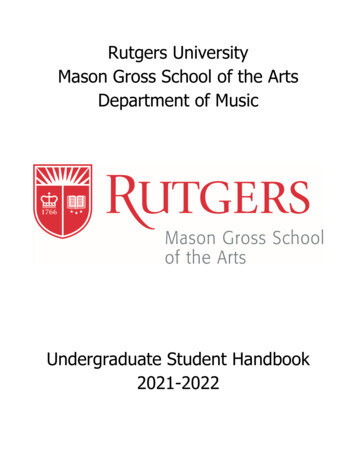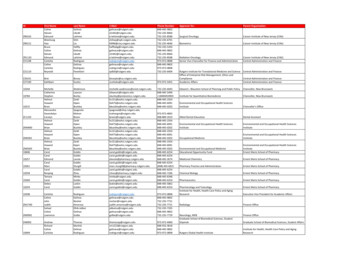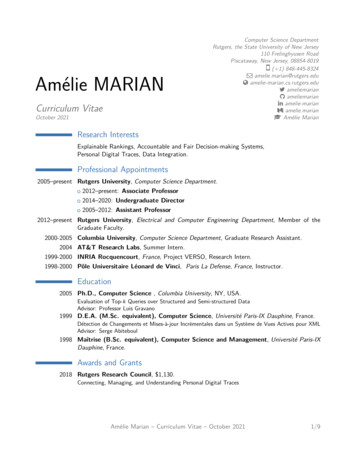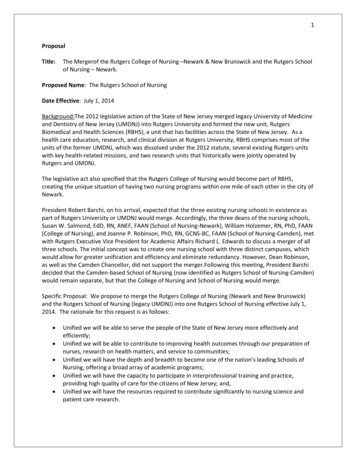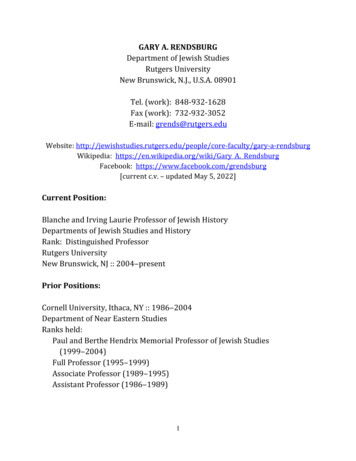
Transcription
GARY A. RENDSBURGDepartment of Jewish StudiesRutgers UniversityNew Brunswick, N.J., U.S.A. 08901Tel. (work): 848-932-1628Fax (work): 732-932-3052E-mail: grends@rutgers.eduWebsite: ty/gary-a-rendsburgWikipedia: https://en.wikipedia.org/wiki/Gary A. RendsburgFacebook: https://www.facebook.com/grendsburg[current c.v. – updated May 5, 2022]Current Position:Blanche and Irving Laurie Professor of Jewish HistoryDepartments of Jewish Studies and HistoryRank: Distinguished ProfessorRutgers UniversityNew Brunswick, NJ :: 2004‒presentPrior Positions:Cornell University, Ithaca, NY :: 1986‒2004Department of Near Eastern StudiesRanks held:Paul and Berthe Hendrix Memorial Professor of Jewish Studies(1999‒2004)Full Professor (1995‒1999)Associate Professor (1989‒1995)Assistant Professor (1986‒1989)1
Canisius College, Buffalo, NY :: 1980‒1986Department of Religious StudiesAssistant Professor of Biblical StudiesVisiting Positions:Getty Villa Residential Research FellowGetty Villa, Los Angeles, California – April-June 2022University of OxfordOxford Centre for Hebrew and Jewish StudiesVisiting Scholar (on five occasions)Oxford, England – July 2018 / July 2017 / June-July 2014 / June-December2012 / October 2010 – February 2011University of CambridgeTaylor-Schechter Cairo Genizah Research UnitVisiting Researcher (on two occasions)Cambridge, England – July 2017 / June-July 2015Tyndale HouseCambridge, England – June-July 2015Visiting ResearcherBrite Divinity School – Texas Christian UniversityFort Worth, TX – May 2011Barnett Visiting Scholar in Jewish LiteratureUniversity of California, Los Angeles (UCLA)Department of Near Eastern Languages and CulturesVisiting Scholar (on three occasions)September-October 2015 / June-August 2013 / April-June 20112
University of SydneyDepartment of Hebrew, Biblical, and Jewish StudiesMandelbaum Visiting Professor in Jewish Studies (on three occasions)March-May 2019 / February-March 2011 / July-August 2004Colgate UniversityDepartment of Philosophy and ReligionHamilton, NY – academic year 2001‒2002Finard Visiting Professor in Jewish StudiesUniversity of PennsylvaniaCenter for Advanced Judaic StudiesPhiladelphia, PA – academic year 1997‒1998Visiting Research Professor and Teaching FellowHebrew UniversityDepartment of Hebrew LanguageJerusalem, Israel – August-December 1993Visiting Research ProfessorHebrew UniversityDepartment of BibleJerusalem, Israel – January-June 1987Visiting Research ProfessorAdjunct Positions:University of PennsylvaniaPhiladelphia, PA – January-May 2007Adjunct Professor of Near Eastern Languages and CulturesState University of New York at Binghamton (on five occasions)Binghamton, NY – 1991, 1992, 1996, 1998, 2003Adjunct Associate Professor of Judaic Studies3
Christ the King Seminary, East Aurora, NY (on two occasions)Adjunct Assistant Professor of Biblical Studies – 1982, 1985Forthcoming Visiting Positions (2022‒2023):Bar-Ilan UniversityRamat-Gan, Israel – October 2022 – January 2023Visiting ProfessorPontifical Biblical InstituteRome, Italy – February-March 2023Visiting ProfessorEducation:New York UniversityInstitute of Hebrew Culture and EducationPh.D., 1980 / M.A., 1977University of North Carolina at Chapel HillSchool of Journalism and Department of EnglishB.A., 1975Dissertation:“Evidence for Spoken Hebrew in Biblical Times”(revised as Diglossia in Ancient Hebrew, see Publications)4
Courses Taught:Introduction to the Bible IIntroduction to the Bible IIIntroduction to Ancient JudaismThe Dead Sea ScrollsJewish History I: Ancient and MedievalJewish Languages: Classical and MedievalScroll Down: Classical Jewish Texts, from Parchment to InternetThe Bible through Literary EyesWomen in the BibleHow Do We Know This?The Journey Motif in Ancient LiteratureThe English BibleJews in the Islamic WorldBiblical HebrewHistory of the Hebrew LanguageReadings in Biblical Hebrew ProseReadings in Biblical Hebrew PoetryGenesisExodus and ConquestProverbsSong of SongsQoheletAncient EgyptHieroglyphic EgyptianWest Semitic InscriptionsUgariticAramaic5
Administrative Work (at Rutgers University):Chair, Department of Jewish Studies, 2004‒2010Acting Chair, Department of Jewish Studies, January‒June 2014Director of Graduate Studies, Department of Jewish Studies, 2011‒2018Acting Undergraduate Director, Department of Jewish Studies, January-June2021Administrative Work (other):Acting Chair, Department of Near Eastern StudiesCornell University, July-December 1990, 1998‒1999Director of Graduate Studies, Department of Near Eastern StudiesCornell University, 1994‒2001Director of Undergraduate Studies, Department of Near Eastern StudiesCornell University, 1987‒1989Acting Associate Dean, School of Continuing StudiesCanisius College, January-August 1983Editorships:Associate Editor, Encyclopedia of Hebrew Language and Linguistics, 4 vols.(Leiden: Brill, 2013), 2008‒2013.Advisory Board Member, Biblical Literature Studies (in Chinese), 2008‒present.Advisory Board Member, Journal of Hebrew Scriptureshttp://www.jhsonline.org/, 2000‒20196
Book Review Editor, AJS Review, Association for Jewish Studies, 1989‒1997.Editorial Board Member, AJS Review, Association for Jewish Studies, 1989‒2001.Archaeological Experience:Tel Dor, Israel – Summer 1980Caesarea, Israel – Summer 1999Memberships:American Oriental SocietySociety of Biblical LiteratureSociety for Old Testament Study (U.K.)British and Irish Association for Jewish StudiesGuest Lectures:University of OxfordUniversity of CambridgeUniversity of ManchesterUniversity of BirminghamUniversity of NottinghamUniversity College LondonSOAS, LondonTrinity College BristolTrinity College DublinTyndale HouseHebrew UniversityBar-Ilan UniversityTel-Aviv UniversityBen-Gurion UniversityPontifical Biblical InstituteLeiden UniversityTsukuba UniversityJapan Bible SeminaryUniversity of SydneyUniversity of TorontoMcGill UniversityHarvard UniversityJewish Theological SeminaryColgate UniversityBinghamton UniversitySUNY – PurchaseLehigh UniversityPennsylvania State University7
Johns Hopkins UniversitySmithsonian InstitutionLibrary of CongressCatholic UniversityGeorge Washington UniversityAmerican UniversityAndrews UniversityGrand Rapids Theological SeminaryFlint Institute of ArtNorthwestern UniversitySpertus CollegeCollege of CharlestonTulane UniversityLouisiana State UniversityCreighton UniversityUniversity of OklahomaBrite Divinity SchoolLanier Theological LibraryBrigham Young UniversityUtah State UniversityUniversity of ArizonaUniversity of OregonStanford UniversityAmerican Jewish UniversityUC – Los AngelesUC - San DiegoDigital Humanities:www.bensira.org – website devoted to the book of Ben Sira, developed jointlywith Jacob Binstein (launched December 2013).http://jts-ms-r1622-1.org/ – website devoted to JTS MS R1622.1, animportant (albeit incomplete) Mishna manuscript, developed jointly withJoshua Blachorsky, with the assistance of Jacob Binstein (launched May 2015).http://johannes-obadiah.org/ – website devoted to the life of Johannes ofOppido Obadiah the Proselyte, Catholic monk who converted to Judaism in1102 C.E., developed with Peter Shamah, with the assistance of Jacob Binstein(launched August 2018).8
Miscellaneous:Extensive travel to all major archaeological sites in Israel, Egypt, and Jordan.Extensive research at major Hebrew manuscript collections, e.g., BodleianLibrary, Cambridge University Library, Bibliotheca Apostolica Vaticana, FisherLibrary (University of Sydney), Library of the Jewish Theological Seminary,and others.Recipient, National Endowment for the Humanities, Fellowship for CollegeTeachers, 1986‒1987.Recipient, Junior Humanities Faculty Summer Research Fellowship, CornellUniversity, Summer 1988.Recipient, Cornell Fund for the Internationalization of Research in theHumanities, 1991.Frequent offerings in Cornell’s Adult University, Ithaca, NY, 1988‒2002.Tour leader, Cornell’s Adult University in Israel, October 1993.Tour leader, Cornell’s Adult University in Egypt, January 1997.Tour leader, Biblical Archaeology in Israel, for Jewish Explorations, June 2016.Invited Participant, Workshop on “The Grammar and Lexicon of MishnaicHebrew,” Institute for Advanced Studies, Hebrew University, September 1996.Invited Participant, Research Group on “Biblical Hebrew in Its NorthwestSemitic Setting,” Institute for Advanced Studies, Hebrew University, December2001 – January 2002.Frequent lecturer for Biblical Archaeology Society, 1998‒present.9
Developer and instructor of “The Book of Genesis,” marketed by The TeachingCompany “Great Courses” program, released 2006.Developer and instructor of “The Dead Sea Scrolls,” marketed by The TeachingCompany “Great Courses” program, released 2010.Regular lecturer for Smithsonian Associates at the Smithsonian Institution,2017‒present.Regular lecturer for One Day University, 2021‒present.Regular lecturer for Jewish Historical Seminars (Jerusalem), 2020‒present.Visiting lecturer, Skidmore College Summer Seminar in Judaic Studies, July2002, July 2005.Invited Participant, International Workshop on Israelian Hebrew, TsukubaUniversity, Tsukuba, Japan, July-August 2002.Frequent referee for academic journals and publishers.Frequent referee for tenure and promotion cases (concern for confidentialityprevents me from presenting a sample list).Publications:7 books written, 10 books edited, c. 200 articles written, numerous reviewessays and book reviews.See the following pages for a complete list. Or go culty/gary-a-rendsburg/gary-a-rendsburg(with pdf files of most of my published articles available there)10
GARY A. RENDSBURGPUBLICATIONSBOOKS AUTHORED1. The Redaction of Genesis (Winona Lake, IN: Eisenbrauns, 1986/2014).2. Diglossia in Ancient Hebrew (American Oriental Series 72; New Haven:American Oriental Society, 1990).3. Linguistic Evidence for the Northern Origin of Selected Psalms (Society ofBiblical Literature Monograph Series 43; Atlanta: Scholars Press, 1990).4. The Bible and the Ancient Near East, co-authored with Cyrus H. Gordon(New York: W. W. Norton, 1997).Polish translation: Biblia i starożytny Bliski Wschód (Warsaw:Proszynski I Ska, 1998).Hungarian translation: A Biblia és az ókori Közel-Kelet, translated byAR gnes Kmilcsik (Debrecen: Gold Book, 2006).5. Israelian Hebrew in the Book of Kings (Occasional Publications of theDepartment of Near Eastern Studies and the Program of Jewish Studies,Cornell University 5; Bethesda, MD: CDL Press, 2002).6. Solomon’s Vineyard: Literary and Linguistic Studies in the Song of Songs, coauthored with Scott B. Noegel (SBL Ancient Israel and Its Literature; Atlanta:Society of Biblical Literature, 2009 / Leiden: Brill, 2009).7. How the Bible Is Written (Peabody, Mass.: Hendrickson, 2019).11
BOOKS EDITED1. Co-Editor, The Bible World: Essays in Honor of Cyrus H. Gordon (New York:Ktav, 1980)2. Co-Editor, Eblaitica: Essays on the Ebla Archives and Eblaite Language, Vol.1 (Winona Lake, IN: Eisenbrauns, 1987).3. Co-Editor, Eblaitica: Essays on the Ebla Archives and Eblaite Language, Vol.2 (Winona Lake, IN: Eisenbrauns, 1990).4. Co-Editor, Eblaitica: Essays on the Ebla Archives and Eblaite Language, Vol.3 (Winona Lake, IN: Eisenbrauns, 1992).5. Co-Editor, Eblaitica: Essays on the Ebla Archives and Eblaite Language, Vol.4 (Winona Lake, IN: Eisenbrauns, 2002).6. Associate Editor, Encyclopaedia of Hebrew Language and Linguistics, 4 vols.(Leiden: Brill, 2013): nd-linguistics7. Co-Editor, “Did I Not Bring Israel Out of Egypt?” Biblical, Archaeological, andEgyptological Perspectives on the Exodus Narratives (Bulletin for BiblicalResearch Supplement 13; Winona Lake, Ind.: Eisenbrauns, 2016).8. Co-Editor, Le-maʿan Ziony: Essays in Honor of Ziony Zevit (Eugene, Ore.:Cascade Books, 2017).9. Co-Editor, James S. Diamond, Scribal Secrets: Extraordinary Texts in theTorah and Their Implications (Eugene, Ore: Pickwick Publications, 2019).10. Co-Editor, Thanksgiving Hymns and Related Documents (The PrincetonTheological Seminary Dead Sea Scrolls Project, vol. 5A; Tübingen: MohrSiebeck / Louisville: Westminster John Knox Press, forthcoming).12
ARTICLES1. “Janus Parallelism in Gen 49:26,” Journal of Biblical Literature 99 (1980),pp. 291–293.2. “Hebrew ʾšdt and Ugaritic išdym,” Journal of Northwest Semitic Languages 8(1980), pp. 81–84.3. “The Danites,” Archiv Orientalni 48 (1980), pp. 150–152 [as part of “AdanaRevisited” co-authored with Yoel Arbeitman].4. “Late Biblical Hebrew and the Date of ‘P’,” Journal of the Ancient NearEastern Society 12 (1980), pp. 65–80.5. “Merneptah in Canaan,” Journal of the Society for the Study of EgyptianAntiquities 11 (1981), pp. 171–172. [with Corrigenda printed as supplementto JSSEA 12 (1982)].6. “Diglossia in Ancient Hebrew as Revealed Through Compound Verbs,” inYoel L. Arbeitman and Allan R. Bomhard, eds., Bono Homini Donum: Essays inHistorical Linguistics in Memory of J. Alexander Kerns (Amsterdam: JohnBenjamins, 1981), pp. 665–677.7. “A Reconstruction of Moabite-Israelite History,” Journal of the Ancient NearEastern Society 13 (1981), pp. 67–73.8. “Laqtil Infinitives: Yiphʿil or Hiphʿil?” Orientalia 51 (1982), pp. 231–238.9. “Double Polysemy in Gen 49:6 and Job 3:6,” Catholic Biblical Quarterly 44(1982), pp. 48–51.10. “Semitic PRZL/BRZL/BRDL ‘Iron’,” Scripta Mediterranea 3 (1982), pp. 54–71.11. “A New Look at Pentateuchal HWʾ,” Biblica 63 (1982), pp. 351–369.12. “Dual Personal Pronouns and Dual Verbs in Hebrew,” Jewish QuarterlyReview 73 (1982), pp. 38–58.13
13. “On Jan Best’s ‘Decipherment’ of Minoan Linear A,” Journal of the AncientNear Eastern Society 14 (1982), pp. 79–87.14. “Jan Best and Minoan Linear A,” Newsletter for Ugaritic Studies 30 (1983),p. 11.15. “Hebrew RḤM ‘Rain’,” Vetus Testamentum 33 (1983), pp. 357–362.16. “Notes on Genesis XXXV,” Vetus Testamentum 34 (1984), pp. 361–366.17. “UT 68 and the Tell Asmar Seal,” Orientalia 53 (1984), pp. 448–452.18. “David and His Circle in Genesis XXXVIII,” Vetus Testamentum 36 (1986),pp. 438–446.19. “Gen 10:13–14: An Authentic Hebrew Tradition Concerning the Origin ofthe Philistines,” Journal of Northwest Semitic Languages 13 (1987), pp. 89–96.20. “Eblaite ù-ma and Hebrew wm-,” in Cyrus H. Gordon, Gary A. Rendsburg,and Nathan H. Winter, eds., Eblaitica: Essays on the Ebla Archives and EblaiteLanguage, Vol. 1 (Winona Lake, IN: Eisenbrauns, 1987), pp. 33–41.21. “Modern South Arabian as a Source for Ugaritic Etymologies,” Journal ofthe American Oriental Society 107 (1987), pp. 623–628.22. “Hebrew šw/yḥ and Arabic šḫḫ,” in Yoel L. Arbeitman, ed., Fucus: ASemitic/Afrasian Gathering in Remembrance of Albert Ehrman (Amsterdam:John Benjamins, 1988), pp. 419–430.23. “More on Hebrew šibbōlet,” Journal of Semitic Studies 33 (1988), pp. 255–258.24. “The Ammonite Phoneme /T/,” Bulletin of the American Schools of OrientalResearch 269 (1988), pp. 73–79.25. “Bilingual Wordplay in the Bible,” Vetus Testamentum 38 (1988), pp. 354–357.14
26. “The Egyptian Sun-God Ra in the Pentateuch,” Henoch 10 (1988), pp. 3–15.27. “The Mock of Baal in 1 Kings 18:27,” Catholic Biblical Quarterly 50 (1988),pp. 414–417.28. “Jews in Persia, Then and Now,” Midstream 34:2 (1988), pp. 44–45.29. “Literary Structures in the Qurʾanic and Biblical Stories of Joseph,” TheMuslim World 78 (1988), pp. 118–120.30. “The Northern Origin of ‘The Last Words of David’ (2 Sam 23,1–7),”Biblica 69 (1988), pp. 113–121.31. “Additional Notes on ‘The Last Words of David’ (2 Sam 23, 1–7),” Biblica70 (1989), pp. 403–408.32. “Black Athena: An Etymological Response,” Arethusa (Special Issue Fall1989), pp. 67–82.33. “Sabaic Notes to Hebrew Grammar,” Abr-Nahrain 27 (1989), pp. 106–119.34. “ לשוח in 1QS 7.15,” Journal for the Study of the Pseudepigrapha 5 (1989),pp. 83–94.35. “Josephus, Flavius,” in Lucian Boia, ed., Great Historians from Antiquity to1800 (New York: Greenwood Press, 1989), pp. 297–298.36. “The Internal Consistency and Historical Reliability of the BiblicalGenealogies,” Vetus Testamentum 40 (1990), pp. 185–206.37. “Redactional Structuring in the Joseph Story: Genesis 37–50,” in Vincent L.Tollers and John Maier, eds., Mappings of the Biblical Terrain: The Bible as Text Bucknell Review 33:2 (Lewisburg, PA: Bucknell University Press, 1990), pp.215–232.15
38. “Monophthongization of aw/ay ā in Eblaite and in Northwest Semitic,”in Cyrus H. Gordon and Gary A. Rendsburg, eds., Eblaitica: Essays on the EblaArchives and Eblaite Language, Vol. 2 (Winona Lake, IN: Eisenbrauns, 1990),pp. 91–126.39. “Targum Onqelos to Exod 10:5, 10:15, Numb 22:5, 22:11,” Henoch 12(1990), pp. 15–17.40. “The Northern Origin of Nehemiah 9,” Biblica 72 (1991), pp. 348–366.41. “Baasha of Ammon,” Journal of the Ancient Near Eastern Society 20 (1991),pp. 57–61.42. “Parallel Developments in Mishnaic Hebrew, Colloquial Arabic, and OtherVarieties of Spoken Semitic,” in Alan S. Kaye, ed., Semitic Studies in Honor ofWolf Leslau, Vol. 2 (Wiesbaden: Otto Harrassowitz, 1991), pp. 1265–1277.43. “A Further Note on Purple Dyeing,” Biblical Archaeologist 54 (1991), p.121.44. “The Strata of Biblical Hebrew,” Journal of Northwest Semitic Languages17 (1991), pp. 81–99.45. “Notes on Genesis XV,” Vetus Testamentum 42 (1992), pp. 266–272.46. “Eblaite sa-su-ga-lum Hebrew ssʿgr,” in Cyrus H. Gordon and Gary A.Rendsburg, eds., Eblaitica: Essays on the Ebla Archives and Eblaite Language,Vol. 3 (Winona Lake, IN: Eisenbrauns, 1992), pp. 153–155.47. “Shibboleth,” in David N. Freedman, ed., The Anchor Bible Dictionary,Volume 5 (New York: Doubleday, 1992), pp. 1210–1212.48. “The Dead Sea Scrolls,” Cornell Alumni News (April 1992), pp. 21–25.49. “The Galilean Background of Mishnaic Hebrew,” in Lee I. Levine, ed., TheGalilee in Late Antiquity (New York: Jewish Theological Seminary, 1992), pp.225–240.16
50. “Morphological Evidence for Regional Dialects in Ancient Hebrew,” inWalter R. Bodine, ed., Linguistics and Biblical Hebrew (Winona Lake, IN:Eisenbrauns, 1992), pp. 65–88.51. “The Date of the Exodus and the Conquest/Settlement: The Case for the1100’s,” Vetus Testamentum 42 (1992), pp. 510–527.52. “Kabbîr in Biblical Hebrew: Evidence for Style-switching and Addresseeswitching in the Hebrew Bible,” Journal of the American Oriental Society 112(1992), pp. 649–651.53. “Israelian Hebrew Features in Genesis 49,” in Robert J. Ratner, Lewis M.Barth, Marianne Luijken Gevirtz, and Bruce Zuckerman, eds., Let YourColleagues Praise You: Studies in Memory of Stanley Gevirtz (Part 2) Maarav 8(1992), pp. 161–170.54. “Physiological and Philological Notes to Psalm 137,” Jewish QuarterlyReview 83 (1993), pp. 385–399 [co-authored with S. L. Rendsburg].55. “The Inclusio in Leviticus xi,” Vetus Testamentum 43 (1993), pp. 418–421.56. “The Dialect of the Deir ʿAlla Inscription,” Bibliotheca Orientalis 50 (1993),cols. 309–329.57. “Talpiyyôt (Song 4:4),” Journal of Northwest Semitic Languages 20 (1994),pp. 13–19.58. “On the Writing bytdwd in the Aramaic Inscription from Tel Dan,” IsraelExploration Journal 45 (1995), pp. 22–25.59. “Laśūaḥ in Gen. xxiv 63,” Vetus Testamentum 45 (1995), pp. 558–560.60. “An Essay on Israelite Religion,” in Jacob Neusner, ed., Approaches toAncient Judaism, New Series, Volume 8 (Atlanta: Scholars Press, 1995), pp. 1–17.17
61. “Ha-Kenaʿanit ba-ʾElef ha-Riʾš on Lifne ha-Sefira,” Ha-ʾEnṣiqlopedya haʿIvrit, Supplementary Volume 3 (Tel-Aviv: Sifriyat Poʿalim, 1995), cols. 1017–1019.62. “Linguistic Variation and the ‘Foreign’ Factor in the Hebrew Bible,” IsraelOriental Studies 15 (1995), pp. 177–190.63. “‘Someone Will Succeed in Deciphering Minoan’: Cyrus H. Gordon andMinoan Linear A,” Biblical Archaeologist 59 (1996), pp. 36–43.64. “Biblical Literature as Politics: The Case of Genesis,” in Adele Berlin, ed.,Religion and Politics in the Ancient Near East (Bethesda, MD: University Pressof Maryland, 1996), pp. 47–70.65. “Hebrew Language,” in Jacob Neusner and William Scott Green, eds.,Dictionary of Judaism in the Biblical Period, Volume I (New York: Macmillan,1996), p. 280.66-74. The following entries in R. J. Z. Werblowsky and Geoffrey Wigoder,eds., The Oxford Dictionary of the Jewish Religion (New York: Oxford UniversityPress, 1997):ooooooooo“Abraham,” pp. 5–6.“Ammon and Moab,” p. 44.“Book of Jashar,” p. 138.“Book of the Wars of the Lord,” pp. 138–139.“Genesis, Book of,” pp. 267–268.“Pharaoh,” p. 528.“Philistines,” p. 529.“Phoenicians,” p. 531.“Song of Songs, Book of,” p. 652.These are all reprinted in Adele Berlin, ed. The Oxford Dictionary of theJewish Religion, 2nd edition (New York: Oxford University Press, 2011):o “Abraham,” p. 6.o “Ammon and Moab,” pp. 46–47.18
ooooooo“Book of Jashar,” pp. 148–149.“Book of the Wars of the Lord,” p. 149.“Genesis, Book of,” p. 286.“Pharaoh,” p. 562.“Philistines,” pp. 562–563.“Phoenicians,” p. 565.“Song of Songs, Book of,” p. 697.75. “Ancient Hebrew Phonology,” in Alan S. Kaye, ed., Phonologies of Asia andAfrica (Winona Lake, IN: Eisenbrauns, 1997), pp. 65–83.76. “Double Polysemy in Proverbs 31:19,” in Asma Afsaruddin and A. H.Mathias Zahniser, eds., Humanism, Culture, and Language in the Near East:Studies in Honor of Georg Krotkoff (Winona Lake, IN: Eisenbrauns, 1997), pp.267–274.77. “Eblaites,” in Eric M. Meyers, ed., The Oxford Encyclopedia of Archaeologyin the Near East (New York: Oxford University Press, 1997), Vol. 2, pp. 183–184.78. “The Early History of Israel,” in Gordon D. Young, Mark W. Chavalas, andRichard E. Averbeck, eds., Crossing Boundaries and Linking Horizons: Studies inHonor of Michael C. Astour on His 80th Birthday (Bethesda, MD: CDL Press,1997), pp. 433–453.79. “The Guilty Party in 1 Kings iii 16–28,” Vetus Testamentum 48 (1998), pp.534–541.80. “On the Potential Significance of the Linear A Inscriptions RecentlyExcavated in Israel,” Aula Orientalis 16 (1998), pp. 289–291.81. “Notes on Israelian Hebrew (I),” in Yitzhak Avishur and Robert Deutsch,eds., Michael: Historical, Epigraphical and Biblical Studies in Honor of Prof.Michael Heltzer (Tel-Aviv: Archaeological Center Publications, 1999), pp. 255–258.82. “Psalm cx 3b,” Vetus Testamentum 49 (1999), pp. 548–553.19
83. “Down with History, Up with Reading: The Current State of BiblicalStudies,” McGill University Jewish Studies 30th Anniversary Conference (1999),electronic version, on the web ocs/Current Biblical studies.htm.84. “Confused Language as a Deliberate Literary Device in Biblical HebrewNarrative,” Journal of Hebrew Scriptures, volume 2 (1998–99), on the web athttp://www.jhsonline.org/Articles/article 12.pdf.Reprinted in: Ehud Ben Zvi, ed., Perspectives on Hebrew Scriptures I(Perspectives on Hebrew Scriptures and its Contexts 1; Piscataway:Gorgias Press, 2006), pp. 197–213.85. “Hebrew Philological Notes (I),” Hebrew Studies 40 (1999), pp. 27–32.86. “Word Play in Biblical Hebrew: An Eclectic Collection,” in Scott B. Noegel,ed., Puns and Pundits: Word Play in the Bible and in Near Eastern Literature(Bethesda, MD: CDL Press, 2000), pp. 137–162.87. “Šimuš Bilti Ragil šel Kinnuy ha-Remez ba-Miqraʾ: ʿEdut Nosefet le-ʿIvritṣefonit bi-Tqufat ha-Miqraʾ,” Shnaton 12 (2000), pp. 83–88.88. “Literary Devices in the Story of the Shipwrecked Sailor,” Journal of theAmerican Oriental Society 120 (2000), pp. 13–23.89. “Notes on Israelian Hebrew (II),” Journal of Northwest Semitic Languages26 (2000), pp. 33–45.90. “Is Linear A Semitic?” Biblical Archaeology Review 26:6 (NovemberDecember 2000), pp. 60–61.91. “Reading David in Genesis: How We Know the Torah Was Written in theTenth Century B.C.E.,” Bible Review 17:1 (February 2001), pp. 20–33, 46.92. “Cyrus H. Gordon, 1908–2001,” Biblical Archaeology Review 27:4(July/August 2001), p. 18.20
93. “Biblical Hebrew,” in Jane Garry and Carl Rubino, eds., Facts About theWorld’s Languages: An Encyclopedia of the World’s Major Languages, Past andPresent (New York: H. W. Wilson, 2001), pp. 291–295.94. “An Additional Note to Two Recent Articles on the Number of People inthe Exodus from Egypt and the Large Numbers in Numbers i and xxvi,” VetusTestamentum 51 (2001), pp. 392–396.95. “Hebrew Philological Notes (II),” Hebrew Studies 42 (2001), pp. 187–195.96. “Cyrus H. Gordon (1908–2001): A Giant Among Scholars,” JewishQuarterly Review 92 (2001), pp. 137–143.97. “Some False Leads in the Identification of Late Biblical Hebrew Texts: TheCases of Genesis 24 and 1 Samuel 2:27–36,” Journal of Biblical Literature 121(2002), pp. 23–46.98. “The Literary Approach to the Bible and Finding a Good Translation,” inFrederick W. Knobloch, ed., Biblical Translation in Context (Bethesda, MD:University Press of Maryland, 2002), pp. 179–194.99. “Once More the Dual: With Replies to J. Blau and J. Blenkinsopp,” AncientNear Eastern Studies 38 (2001), pp. 28–41.100. “Eblaite and Some Northwest Semitic Lexical Links,” in Cyrus H. Gordonand Gary A. Rendsburg, eds., Eblaitica: Essays on the Ebla Archives and EblaiteLanguage, Vol. 4 (Winona Lake, IN: Eisenbrauns, 2002), pp. 199–208.101. “Hebrew Philological Notes (III),” Hebrew Studies 43 (2002), pp. 21–30.102. “Unlikely Heroes: Women as Israel,” Bible Review 19:1 (February 2003),pp. 16–23, 52–53.103. “Beasts or Bugs? Solving the Problem of the Fourth Plague,” Bible Review19:2 (April 2003), pp. 18–23.21
104. “Hurvitz Redux: On the Continued Scholarly Inattention to a SimplePrinciple of Hebrew Philology,” in Ian Young, ed., Biblical Hebrew: Studies inChronology and Typology (London: Continuum, 2003), pp. 104–128.105. “ ( נגדה נא לכל עמו Psalm cxvi 14b, 18b),” Vetus Testamentum 53 (2003),pp. 328–336 [co-authored with J. P. Fokkelman].106. “A Comprehensive Guide to Israelian Hebrew: Grammar and Lexicon,”Orient 38 (2003), pp. 5–35.107. “The Geographical and Historical Background of the Mishnaic HebrewLexicon,” Orient 38 (2003), pp. 105–115.108. “Writing and Scripts (with Special Reference to the Levant),” in SuzanneRichard, ed., Near Eastern Archaeology: A Reader (Winona Lake, IN:Eisenbrauns, 2003), pp. 63–70.109. “Semitic Languages (with Special Reference to the Levant),” in SuzanneRichard, ed., Near Eastern Archaeology: A Reader (Winona Lake, IN:Eisenbrauns, 2003), pp. 71–73.110. “Millat ha-Qiyyum אשׁ ,”ִ Meḥqarim be-Lashon 9 (2003), pp. 251–255.111. “Cyrus H. Gordon, the First American-Born, American-Trained JewishBible Scholar to Accede to a University Position: In Commemoration of the350th Anniversary of Jews in North America” (2004), electronic version, onthe web at http://www.sbl-site.org/Article.aspx?ArticleId 343.112. “The Vegetarian Ideal in the Bible,” in Leonard J. Greenspoon, Ronald A.Simkins, and Gerald Shapiro, eds., Food and Judaism (Studies in JewishCivilization, volume 15; Omaha: Creighton University Press, 2005), pp. 319–334. [See also no. 174 below.]22
113. “Investiture Address,” in The Blanche and Irving Laurie Chair in JewishHistory, Separatum published by the Allen and Joan Bildner Center for theStudy of Jewish Life, Rutgers, The State University of New Jersey (2005), pp.5–10.114. “The Genesis of the Bible,” in The Blanche and Irving Laurie Chair inJewish History, Separatum published by the Allen and Joan Bildner Center forthe Study of Jewish Life, Rutgers, The State University of New Jersey (2005),pp. 11–30. [See also no. 135 below.]115. “Israelian Hebrew in the Song of Songs,” in Steven E. Fassberg and AviHurvitz, eds., Biblical Hebrew in Its Northwest Semitic Environment:Typological and Historical Perspectives (Publications of the Institute forAdvanced Studies 1; Jerusalem: Magnes Press; and Winona Lake, IN:Eisenbrauns, 2006), pp. 315–323.116. “Moses as Equal to Pharaoh,” in Gary M. Beckman and Theodore J. Lewis,eds., Text, Artifact, and Image: Revealing Ancient Israelite Religion (BrownJudaic Studies 346; Providence: Brown Judaic Studies, 2006), pp. 201–219.117. “Aramaic-like Features in the Pentateuch,” Hebrew Studies 47 (2006), pp.163–176.118. “Ebla,” in Encyclopaedia Judaica, Second Edition, vol. 6 (Jerusalem: KeterPublishing House; Detroit: Thomson-Gale, 2007), pp. 85–87.119. “The Biblical Flood Story in the Light of the Gilgameš Flood Account,”Ancient Near Eastern Studies, Supplement 21 Joseph Azize and Noel Weeks,eds., Gilgameš and the World of Assyria: Proceedings of the Conference held atMandelbaum House, The University of Sydney, 21–23 July 2004 (Leuven:Peeters, 2007), pp. 115–127.120. “Ancient Hebrew Morphology,” in Alan S. Kaye, ed., Morphologies of Asiaand Africa (Winona Lake, IN: Eisenbrauns, 2007), pp. 85–105.23
121. “No Stelae, No Queens: Two Issues Concerning the Kings of Israel andJudah,” in Douglas R. Edwards and C. Thomas McCullough, eds., TheArchaeology of Difference: Gender, Ethnicity, Class and the “Other” in Antiquity:Studies in Honor of Eric M. Meyers (The Annual of the American Schools ofOriental Research 60–61; Boston: American Schools of Oriental Research,2007), pp. 95–107.122. “Israel Without the Bible,” in Frederick E. Greenspahn, ed., The HebrewBible: New Insights and Scholarship (Jewish Studies in the Twenty-FirstCentury Series; New York: New York University Press, 2007), pp. 3–23.123. “ ואשב in Mesha Stele line 12,” Maarav 14 (2007), pp. 9–25.124. “Alliteration in the Exodus Narrative,” in Chaim Cohen, Victor A.Hurowitz, Avi Hurvitz, Yohanan Muffs, Baruch J. Schwartz, and Jeffrey H.Tigay, eds., Birkat Shalom: Studies in the Bible, Ancient Near Eastern Literature,and Postbiblical Judaism Presented to Shalom M. Paul on the Occasion of HisSeventieth Birthday (Winona Lake, Ind.: Eisenbrauns, 2008), pp. 83–100.125. “The Two Screens: On Mary Douglas’s Proposal for a Literary Structureto the Book of Leviticus,” Jewish Studies Quarterly 15 (2008), pp. 175–189.126. “Qetaʿ Shenat ha-Yovel (Vayyiqraʾ 25:8–24) ke-Ḥibbur Ṣefoni,” Meḥqarimbe-Lashon 11–12 (2008) Sefer ha-Yovel le-Avi Hurvitz, pp. 297–308.127. “A Proper View of Arabic, Semitic, and More,” Journal of the AmericanOrienta
Christ the King Seminary, East Aurora, NY (on two occasions) Adjunct Assistant Professor of Biblical Studies - 1982, 1985 Forthcoming Visiting Positions (2022‒2023): Bar-Ilan University Ramat-Gan, Israel - October 2022 - January 2023 Visiting Professor Pontifical Biblical Institute Rome, Italy - February-March 2023 Visiting Professor
